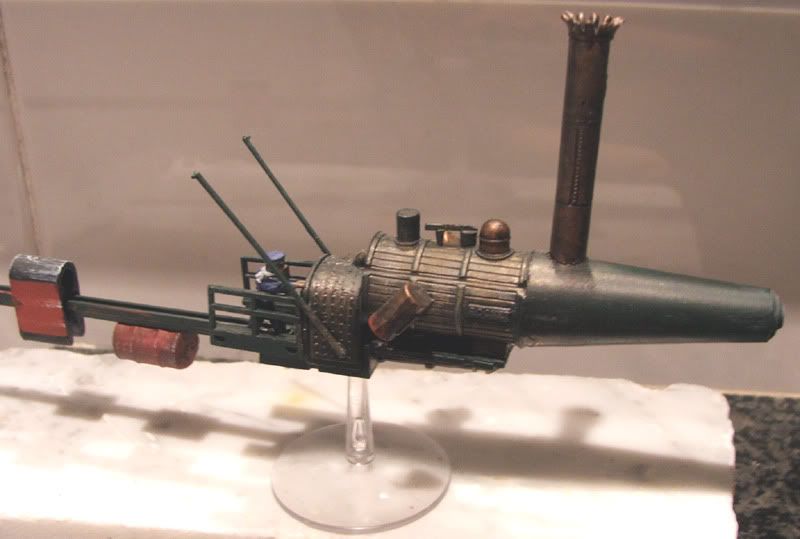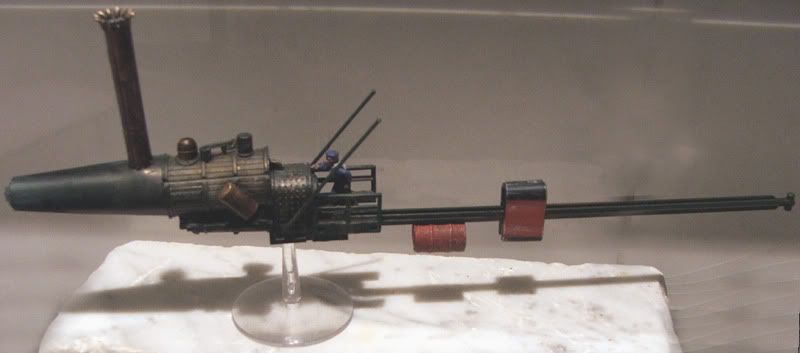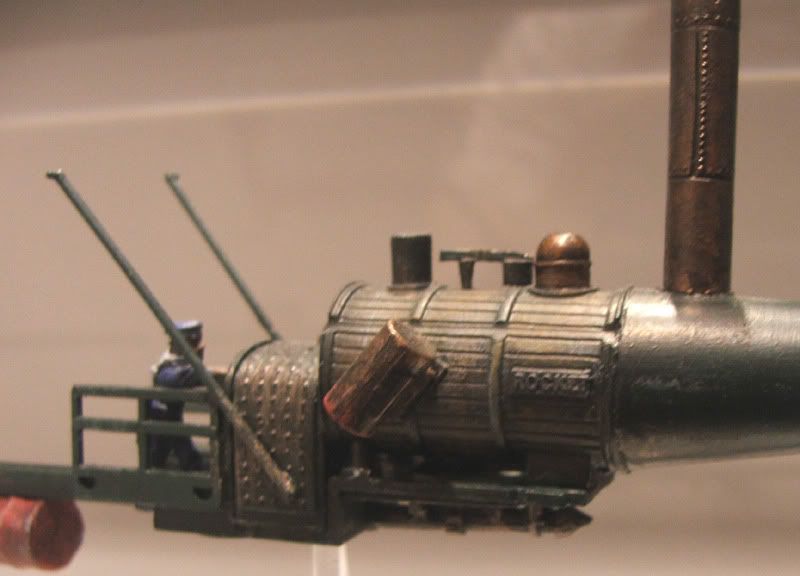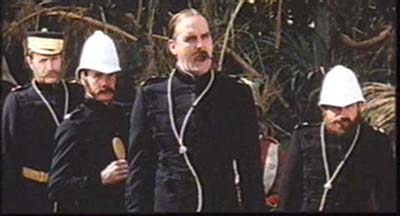http://www.brigademodels.co.uk/phpbb2/viewtopic.php?p=7009#7009
And see some pics of the great looking fleets here:
http://www.flickr.com/photos/7664665@N03/sets/72157622986195199/detail
Huzzah!

Whats the humdrum about Chaps? Adventures into Victorian Science Fiction and Steampunk with ramblings about Aeronefs, Dirigibles, Land Ironclads, Anarchists, Dinosaur Hunting, Terranefs, Aquanefs, Mad Scientists, and all manner of electric contraptions and steam conveyances. It may not make sense, but there will be claret and a nice cheese board at the end. Tally-Ho and "Vôtre dans une sauce au vin blanc!"

 We hope to re-commence production of vital war supplies as soon as possible.
We hope to re-commence production of vital war supplies as soon as possible.

 This seems quite apt after my recent dig at the Frogs!! (http://pauljamesog.blogspot.com/2009/10/complete-military-history-of-france.html)
This seems quite apt after my recent dig at the Frogs!! (http://pauljamesog.blogspot.com/2009/10/complete-military-history-of-france.html)








It was great fun making these and I am sure the next lot will be even better.
I hope you enjoy this piece of Aeronef history as much as I did digging them out!

 http://captainshrike.blogspot.com/
http://captainshrike.blogspot.com/








 I also like the options for seperate throw down islands and coastline.
I also like the options for seperate throw down islands and coastline.





 The model comes in 5 separate parts: hull, 2 main turrets, breastwork superstructure and mast. All part were very crisply cast with no flash at all. All fit together nicely with no filler required. One particularly good feature is that the breastwork structure fits over the turrets, which in tun have a peg and hole fitting. This means that they the turrets can be painted and fitted without gluing, so they can rotate freely.
The model comes in 5 separate parts: hull, 2 main turrets, breastwork superstructure and mast. All part were very crisply cast with no flash at all. All fit together nicely with no filler required. One particularly good feature is that the breastwork structure fits over the turrets, which in tun have a peg and hole fitting. This means that they the turrets can be painted and fitted without gluing, so they can rotate freely.









Background
The Russalka (Mermaid), a 204foot long ironclad monitor built just months after the loss of the famous USS Monitor, eventually followed her American cousin to the same fate. Built in 1867 she suffered -like the Monitor- from a very low freeboard and poor sea keeping abilities. This led to insufficient flood ability and damage stability. After a quiet 25 years service on the Baltic the poorly designed warship left harbor on her final patrol. She had become largely obsolete and had since past from her place as a first-line battleship to that of a training ship assigned to the Gunnery Training Squadron.
Last Voyage of the Russalka
Never firing a shot in war, the HIH Tsar Alexander’s Imperial Russian Naval Battleship Russalka, sailed from the port of Tallinn (now in Estonia) to Helsingfors (currently Helsinki, Finland) on September 7, 1893. Today this is a regular 80km two hour express ferry service between the capitols of two Baltic countries. In 1893 this was an all day crossing from one Russian naval port to another. That morning the Russalka was to sail with another ship in her squadron, the gunboat Cloud ("Tutysa") at 0730. However Captain 1st Class Victor Hristianovich Ienish arrived aboard the Russalka an hour late from hospital due to a headache caused by concussion received just a few days earlier and the battleship cast off to sea at 0830, trailing her companion.
The morning started with a calm gentle breeze and 2 foot seas but with a gale forecasted. Some 17 miles north of Tallinn the pair of ships had closed to within a half mile of each other but the seas had grown considerably. By lunchtime the Clouds ship's log was noting sea state 5 conditions (16-20 kt winds, 6ft seas with long waves). Having to close her deck air intakes to prevent water from swamping the engines, the Russalka's speed dropped considerably and the distance between the two ships increased. The seas and wind increased to a strong gale and the two ships became further and further separated. Eventually they were over the horizon from each other, separated by the then 40 kt winds and 20 foot rolling waves of a fierce Baltic storm. The Cloud arrived in Helsingfors at 1500 and waited for her companion. She was to have a very long wait.
The Search for the Russalka
The next morning when the Russalka did not appear either in Helsingfors or back in Tallinn, Rear Admiral Buracheka ordered a search by all available ships. For 37 days dozens of ships crossed the Gulf of Finland looking for the overdue battleship but only found remnants. The Russalka's lifeboats were found un-used as if washed off deck and cast about the sea as were empty lifebelts and life rings. On September 15 the body of seaman 2nd class Ivan Prunskogo, a lookout from the Russalka washed ashore near the fortress of Sveaborg (now Suomenlinna). He was the only soul of the 12 officers and 165 crewmen to ever be found. A court of inquiry led by Rear Admiral Syridov found that Rear Admiral Buracheka, commander of the Gunnery Training Squadron had been negligent in ordering the ships to sea with bad weather on the horizon. Captain 2nd Rate Nikolay Mikhailovich Luzhkov, commander of the Cloud was dismissed from the service for leaving the Russalka alone during the storm. He would later die in the naval hospital at Kronstadt a broken man after his only son would die a hero a decade later aboard the Russian battleship Petropavlosk during the Russo-Japanese war.
The Russalka Remembered
The name Russalka was retired from the rolls of the Russian Navy and in 1902 a monument of an angel with outstretched arms named after the ship was placed on Kadriorg beach in Tallinn. Pointed at 23 degrees, the course the Russalka took towards Helsingfors, it was made of Finnish granite and carved by Estonian sculptor Amandus Adamason. To this day flowers and wreaths are laid at the feet of the angel for the lost souls.
In July 2003 the Russalka was found at the depth 74 meters some 25 miles south of Helsinki by the Estonian State Maritime Museum (Meremuuseum) research vessel Mare. The wreck is standing vertically almost upright, with her bow deep in the mud and the stern rising some 100 feet from the bottom. Now that she has been located after 110 years an investigation is under way to finally determine how the Russalka was lost.
Read more: http://ww1history.suite101.com/article.cfm/the_mystery_of_the_russalka
http://ww1history.suite101.com/article.cfm/the_tsars_battleship_russalka



